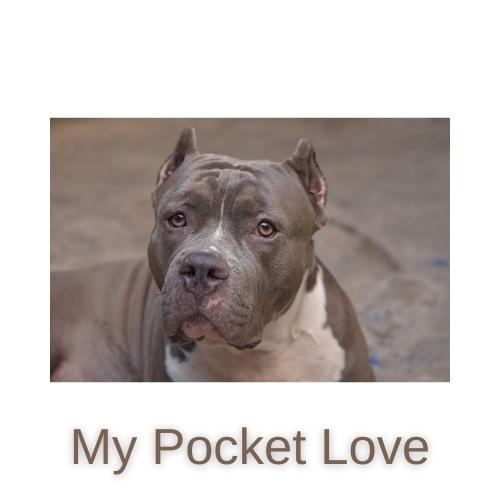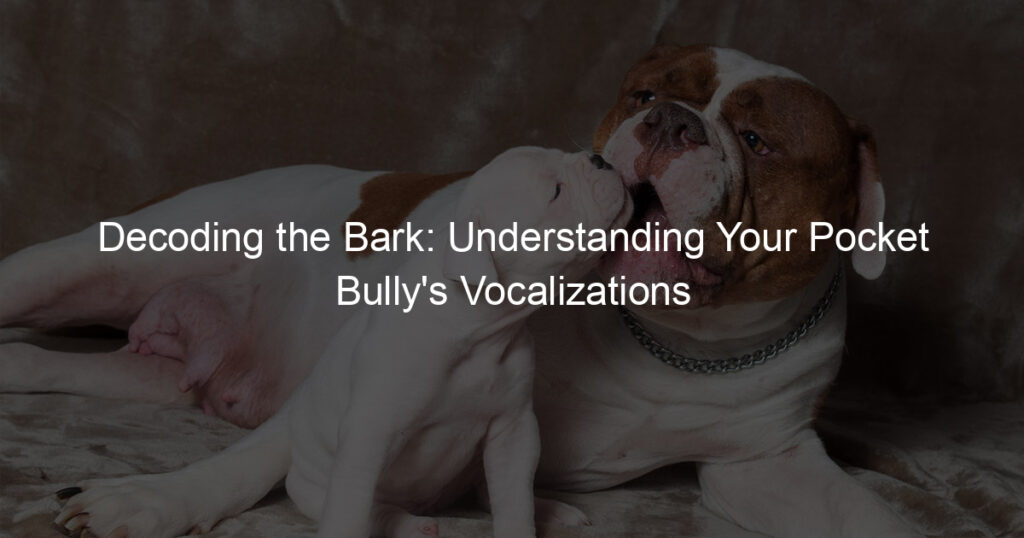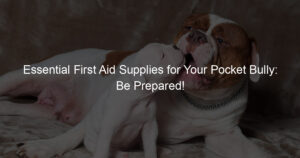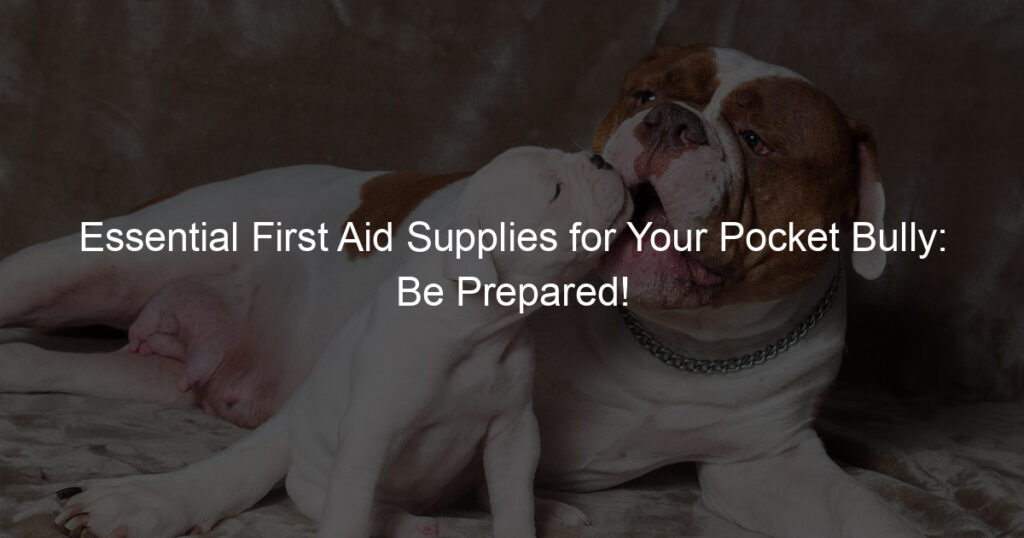
Introduction to Pocket Bullies Behavior
The Pocket Bully, a smaller version of the American Bully, is a breed known for its strong, muscular build and friendly demeanor. Despite their intimidating appearance, these dogs are often misunderstood. In this article, we will delve into the behavior of Pocket Bullies, providing an overview of their characteristics and debunking common misconceptions about this breed.
- Overview of the breed’s characteristics
- Common misconceptions about Pocket Bullies
Pocket Bullies are compact, sturdy, and muscular dogs that stand between 12 to 16 inches tall. They are known for their wide, flat heads and short, broad snouts. Despite their tough exterior, Pocket Bullies are incredibly affectionate, loyal, and friendly. They are excellent with children and make great family pets.
These dogs are intelligent and eager to please, making them relatively easy to train. However, they require a firm, consistent hand to prevent them from developing bad habits. Pocket Bullies are also known for their high energy levels and need regular exercise to keep them healthy and happy.
One of the most common misconceptions about Pocket Bullies is that they are aggressive or dangerous. This is largely due to their muscular build and the negative stereotypes associated with bully breeds. However, aggression is not a characteristic of the breed. Pocket Bullies are, in fact, known for their gentle and friendly nature.
Another misconception is that Pocket Bullies are difficult to train. While they do require a firm hand, these dogs are intelligent and eager to please. With consistent training and positive reinforcement, they can learn quickly and effectively.
In conclusion, Pocket Bullies are a misunderstood breed. They are friendly, loyal, and great with families, making them excellent pets. It’s important to remember that a dog’s behavior is largely influenced by its upbringing and training, not just its breed. With proper care and training, a Pocket Bully can be a wonderful addition to any family.
Understanding Dog Vocalizations
One of the most fascinating aspects of owning a dog is learning to understand their unique ways of communication. Dogs use a variety of vocalizations to express their feelings and intentions. Let’s delve into the world of dog barks and what they mean.
Decoding Dog Barks
Just as humans use different tones and volumes to convey different emotions, dogs also use a variety of barks to communicate. Here are some key insights into interpreting dog barks and understanding the context in which they occur.
- Interpreting different types of barks
- Understanding the context of barking
Not all barks are created equal. Dogs use different types of barks to express different emotions or intentions. Here are a few common types of barks and what they typically mean:
| Type of Bark | Meaning |
|---|---|
| Continuous, rapid barking | This is often a sign of alarm or distress. Your dog may be alerting you to a perceived threat. |
| Single, sharp bark | This is typically an attention-seeking bark. Your dog may want to play or get your attention for some other reason. |
| Low-pitched, prolonged bark | This is often a sign of discomfort or fear. Your dog may be feeling threatened or anxious. |
The context in which a dog barks can provide valuable clues about what they’re trying to communicate. For example, a dog that barks when the doorbell rings is likely alerting you to the presence of a visitor. On the other hand, a dog that barks when left alone may be expressing feelings of separation anxiety.
By paying attention to the circumstances surrounding your dog’s barking, you can gain a deeper understanding of their needs and emotions. Remember, every dog is unique, and what holds true for one may not necessarily apply to another. The key is to observe and learn from your own dog’s behavior.
Dog Communication Signals
Just like humans, dogs have their own unique ways of communicating. They use a variety of signals, many of which are non-vocal. Understanding these signals can help us better communicate with our furry friends.
- Non-vocal signals in dogs
- How dogs use body language to communicate
Dogs use a range of non-vocal signals to express their feelings and intentions. These include facial expressions, body postures, and movements. For example, a relaxed dog might have a loose, wagging tail, while a scared dog might tuck its tail between its legs. Similarly, a dog that’s ready to play might bow down on its front legs, while a dog that’s feeling threatened might raise its hackles.
Body language is a crucial part of dog communication. Dogs use their entire body, including their ears, eyes, mouth, tail, and even their fur, to convey messages. For instance, a dog with its ears perked up and forward is usually alert and interested, while a dog with its ears flattened back might be scared or submissive. A dog that’s showing its teeth might be aggressive, while a dog that’s panting and wagging its tail is likely happy and relaxed.
By paying attention to these non-vocal signals and body language cues, we can learn to understand what our dogs are trying to tell us. This can lead to a stronger bond and a happier, healthier relationship with our pets.
| Signal | Meaning |
|---|---|
| Loose, wagging tail | Relaxed, happy |
| Tail tucked between legs | Scared, submissive |
| Front legs bowed down | Ready to play |
| Raised hackles | Threatened, aggressive |
| Ears perked up and forward | Alert, interested |
| Ears flattened back | Scared, submissive |
| Showing teeth | Aggressive |
| Panting, wagging tail | Happy, relaxed |
Pocket Bullies Communication
Understanding the communication style of Pocket Bullies is crucial for building a strong bond with your pet. This breed uses a variety of sounds to express their feelings and needs. Let’s delve into the world of Pocket Bullies’ sounds and their meanings.
Interpreting Pocket Bullies Sounds
Just like humans, Pocket Bullies use sounds to communicate. These sounds can convey a range of emotions, from happiness to distress. Let’s explore the common sounds made by Pocket Bullies and what they mean.
- Common sounds made by Pocket Bullies
- What these sounds mean
Pocket Bullies produce a variety of sounds, including barks, growls, whines, and howls. Each sound has a unique tone and pitch, which can help you understand what your pet is trying to communicate.
Each sound made by a Pocket Bully has a specific meaning. A bark can indicate excitement or alertness, while a growl might be a warning or show of dominance. Whines often express discomfort or a desire for attention, and howls can be a sign of loneliness or boredom.
Interpreting these sounds correctly can help you respond appropriately to your pet’s needs, strengthening your bond and ensuring their well-being. Remember, understanding your Pocket Bully’s communication style is a process that requires patience and observation.
Pocket Bullies Barking Meaning
Understanding the barking of Pocket Bullies is an essential part of their communication. The bark of a Pocket Bully is not just a sound; it’s a language. Let’s delve into the meaning behind their barks.
- Understanding why Pocket Bullies bark
- How to respond to different barks
Pocket Bullies, like other dogs, bark for a variety of reasons. They may bark when they’re excited, scared, or bored. They might also bark to alert you of something unusual or to get your attention.
For instance, if your Pocket Bully barks when someone approaches your house, it could be their way of alerting you to a potential intruder. On the other hand, if they bark when you’re preparing their food, it’s likely a sign of excitement and anticipation.
Understanding the context of their barking can help you decipher what they’re trying to communicate. Remember, barking is their way of talking to you!
Responding appropriately to your Pocket Bully’s barks is crucial. If they’re barking out of fear, it’s important to reassure them and make them feel safe. If they’re barking because they’re bored, it might be a sign that they need more physical activity or mental stimulation.
For example, if your Pocket Bully is barking at a stranger, it’s important to reassure them that everything is okay. You can do this by speaking in a calm, soothing voice and petting them gently. If they’re barking because they’re bored, consider taking them for a walk or playing a game with them.
Remember, it’s important not to punish your Pocket Bully for barking. Instead, try to understand what they’re trying to communicate and respond appropriately.
In conclusion, understanding the meaning behind your Pocket Bully’s barks can strengthen your bond with them and help you meet their needs more effectively. So, the next time your Pocket Bully barks, listen closely. They might be trying to tell you something!
Dog Language Translation
Understanding the language of our furry friends, especially Pocket Bullies, can be a fascinating journey. This section will guide you through the common noises made by Pocket Bullies and how to respond to them effectively.
Understanding Pocket Bullies Noises
Pocket Bullies, like other dogs, use a variety of sounds to communicate their feelings, needs, and responses to their environment. Let’s delve into the world of Pocket Bullies’ vocalizations.
- Decoding common noises made by Pocket Bullies
- Barking: This is a common sound that can mean anything from excitement to fear. The key is to pay attention to the pitch and frequency of the bark.
- Whining: This is usually a sign of discomfort or anxiety. If your Pocket Bully is whining, it’s important to find out what’s causing the distress.
- Growling: This can be a warning sign of aggression, but it can also be a playful sound during a game.
- Howling: This is a form of long-distance communication, often triggered by loneliness or boredom.
- How to respond to these noises
- Barking: If your Pocket Bully is barking excessively, try to identify the cause and address it. If it’s due to excitement, you might need to help your dog calm down.
- Whining: Comfort your dog and try to alleviate any distress. If the whining continues, it might be a good idea to consult a vet.
- Growling: If your Pocket Bully is growling aggressively, it’s important to give them space and avoid escalating the situation.
- Howling: If your dog is howling due to loneliness, spending more time with them or providing interactive toys can help.
There are several common noises that Pocket Bullies make, each with its own meaning:
Responding appropriately to your Pocket Bully’s noises can strengthen your bond and make your dog feel understood. Here are some suggestions:
In conclusion, understanding and responding to your Pocket Bully’s noises can greatly enhance your relationship with your pet. Remember, patience and consistency are key in this learning process.
Pocket Bullies Language
Understanding the language of Pocket Bullies and communicating effectively with them is a vital part of building a strong bond with these adorable companions. Let’s delve into these topics.
- Understanding the Language of Pocket Bullies
Pocket Bullies, like all dogs, have a unique language that they use to express their feelings and needs. They communicate through a combination of vocalizations, body language, and facial expressions. For instance, a wagging tail often signifies happiness, while a lowered tail can indicate fear or submission.
When it comes to vocalizations, a high-pitched bark usually signals excitement or eagerness, while a low, deep growl can be a warning sign. It’s important to pay close attention to these cues to understand what your Pocket Bully is trying to communicate.
- How to Communicate Effectively with Your Pocket Bully
Effective communication with your Pocket Bully involves understanding their language and responding appropriately. It’s not just about giving commands; it’s about listening and responding to their needs and emotions.
For instance, if your Pocket Bully is showing signs of fear or stress, it’s important to comfort them and remove them from the stressful situation. On the other hand, if they’re showing signs of excitement or happiness, it’s a great time to engage in play or reward them with a treat.
Remember, consistency is key when communicating with your Pocket Bully. Use the same words and gestures for commands, and always reward good behavior promptly. This will help your Pocket Bully understand what you expect from them and strengthen your bond.
| Sign | Meaning |
|---|---|
| Wagging tail | Happiness |
| Lowered tail | Fear or submission |
| High-pitched bark | Excitement or eagerness |
| Low, deep growl | Warning sign |
Understanding and effectively communicating with your Pocket Bully is a rewarding journey. It not only enhances your relationship with your furry friend but also ensures their happiness and well-being.
Conclusion: Decoding the Bark
As we wrap up our discussion on Pocket Bullies and their vocalizations, it’s important to remember that understanding your dog’s language is a journey. It requires patience, keen observation, and a willingness to learn. Let’s summarize our key takeaways and share some final thoughts on this fascinating topic.
- Summary of Key Takeaways
- Pocket Bullies, like all dogs, use a variety of vocalizations to communicate their feelings and needs.
- These vocalizations can include barks, whines, howls, and growls, each with their own unique meanings.
- Understanding these vocalizations can strengthen the bond between you and your Pocket Bully, leading to a happier and healthier relationship.
- It’s important to respond appropriately to your dog’s vocalizations to reinforce positive behavior and discourage negative behavior.
- Final Thoughts on Understanding Your Pocket Bully’s Vocalizations
Throughout our exploration, we’ve learned several crucial points:
Decoding your Pocket Bully’s bark is more than just a fun exercise. It’s a way to deepen your understanding of your furry friend and respond to their needs in a more effective way. Remember, every dog is unique. Your Pocket Bully may have their own ‘dialect’ or personal quirks when it comes to vocalizations.
As the famous dog trainer, Cesar Millan, once said, “Dogs don’t rationalize. They don’t hold anything against a person. They don’t see the outside of a human but the inside of a human.” So, let’s strive to understand our Pocket Bullies better, not just from their barks, but from their overall behavior and body language as well.
With patience, love, and understanding, you can decode the language of your Pocket Bully’s bark and build a stronger bond with your four-legged friend. Happy decoding!














